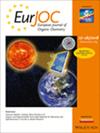高通量实验作为指导微波辅助芳基胺与芳基酸酰胺化的工具
IF 2.5
3区 化学
Q2 CHEMISTRY, ORGANIC
引用次数: 0
摘要
我们利用 DoE、HTE 和微波合成技术开发了一种催化酰胺化协议,该协议遵循绿色化学原则,通过使用催化来提高原子经济性、使用生物可再生溶剂、高底物负载和节能微波加热。本文章由计算机程序翻译,如有差异,请以英文原文为准。


High Throughput Experimentation as a Tool to Guide the Microwave Assisted Catalytic Amidation of Aryl Amines with Aryl Acids
The formation of amides is one of the most essential transformations in the pharmaceutical industry, but most synthetic procedures include the use of stoichiometric poor atom economy reagents. These limitations are often compounded when condensing aryl amines with aryl acids due to their inherently low reactivity. To overcome such hurdles, we utilized high throughput experimentation to screen 640 different reaction conditions to find a suitable catalyst and solvent for benzamide formation. Based on those initial findings, we developed an efficient catalytic transformation of aryl amines with aryl acids into N‐arylbenzamides using a 15 mol % loading of 2,4‐bis(trifluoromethyl) phenyl boronic acid and trimethylamine N‐oxide in 2‐MeTHF under microwave conditions for 1 h in the presence of 3 Å molecular sieves. Our method shows that even sterically hindered amines and carboxylic acids can be converted to the corresponding N‐arylbenzamides, including previously reported unreactive aromatic and secondary amines, in good to excellent yields. This approach follows the principles of green chemistry through use of[1] catalysis to improve atom economy,[2] a biorenewable solvent (2‐MeTHF),[3] high substrate loadings (0.5 M), and[4] energy efficient microwave heating.
求助全文
通过发布文献求助,成功后即可免费获取论文全文。
去求助
来源期刊
CiteScore
5.40
自引率
3.60%
发文量
752
审稿时长
1 months
期刊介绍:
The European Journal of Organic Chemistry (2019 ISI Impact Factor 2.889) publishes Full Papers, Communications, and Minireviews from the entire spectrum of synthetic organic, bioorganic and physical-organic chemistry. It is published on behalf of Chemistry Europe, an association of 16 European chemical societies.
The following journals have been merged to form two leading journals, the European Journal of Organic Chemistry and the European Journal of Inorganic Chemistry:
Liebigs Annalen
Bulletin des Sociétés Chimiques Belges
Bulletin de la Société Chimique de France
Gazzetta Chimica Italiana
Recueil des Travaux Chimiques des Pays-Bas
Anales de Química
Chimika Chronika
Revista Portuguesa de Química
ACH—Models in Chemistry
Polish Journal of Chemistry.

 求助内容:
求助内容: 应助结果提醒方式:
应助结果提醒方式:


